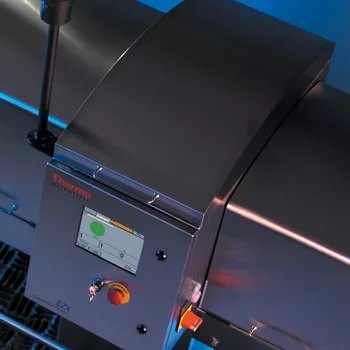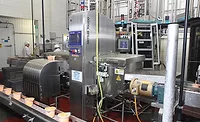X-Ray Contaminant Detection

The basic principle of X-ray is well-known today because of its long-term use in the healthcare industry. What is not so well-known by many food production and quality professionals is what X-ray can do to improve contaminant detection capability compared with traditional metal detectors. Described below are eight reasons to seriously consider stepping up to the latest technology, incorporated into easy-to-use and cost-effective X-ray inspection systems such as the Thermo Scientific EZx.
1. Detect contaminants by “seeing through” metalized film/foil packs
Shelf life and product appearance have always been important in the packaging business. Metalized film or foil packaging materials provide a better vapor and UV-light barrier, extending shelf life. However, these materials trigger sensitive metal detectors, rendering them useless. X-ray systems can inspect right through these packages to detect very small contaminants inside. Such final inspection provides the ultimate in foreign object detection and is a key reason many companies employ X-ray systems when using these latest packaging materials.
2. Find more than just metal contaminants
X-ray measures density. When coupled with computer analysis, X-ray systems can find any dense, sharp-edged contaminant such as glass, stone, plastic and bone. Unlike metal detectors, X-ray systems find most metals (ferrous, non-ferrous and stainless steel) equally because their densities are similar; there is no detection capability trade-off by metal type. Finally, X-ray is usually more sensitive than a metal detector, due to its advanced image generation and detection technology.
3. Set up/test new products in minutes utilizing an intuitive graphical interface
Teaching a metal detector a product’s phase angle requires understanding reactive and resistive signals as well as selection of frequency and gain. With the EZx QuickLearn feature, in five minutes you can tell the system about your package size and line rate, pass a few sample packages through the machine, and quickly test the system to verify that it found the offending contaminants. You can also view, zoom and save the image of a contaminant found during production for further review and root-cause analysis.
4. Don’t worry about phasing out products or trying to track changes anymore
Products that are wet, salty or conductive look like metal to the receivers in a metal detector. Frozen or hot products may change over the day when in production, causing tracking issues that compromise detection sensitivity. X-ray systems are unaffected by the electrical “state” of the product or its temperature. If for some reason a product changes with time, you can quickly view the product image and make adjustments online.
5. Compact, complete design means installation is done in hours
X-ray systems are small in size so adding one into a production line is easy. Start-up assistance helps customers inspect products the same day. Training is included and a full radiation safety-check to your local regulations is performed. You need not worry about noisy power, electromagnetic fields from variable frequency drives (VFDs), ground loops in conveyors or vibration—all of which can make metal detector installation difficult and time-consuming.
6. Complete production statistics and image storage are standard
In most production environments, maintaining records of production information along with contaminants detected by metal detectors is daunting. Proprietary networking solutions can lock you into a particular vendor, or low-level protocols can require custom programming. With EZx, all production statistics are saved right on the system for one month and are easily viewed and transferred to any PC via USB or Ethernet FTP connection. If there is a problem, complete records—including rejected product images—are there.
7. X-ray systems are now as safe to use as metal detectors
Years ago, X-ray systems were perceived as a potential health hazard. For this reason, organizations like the U.S. Food and Drug Administration set standards on safety-related measures and tests necessary to sell and install X-ray inspection machines. Today, thousands of machines inspect food every day around the world, all certified to these very stringent standards. The EZx complies with these standards and is installed in over 20 countries around the world.
8. X-ray systems today have an attractive total cost of ownership (TCO)
Years ago, X-ray systems cost 5–10 times more than metal detectors and over the course of five years or more, customers needed to purchase expensive parts such as tubes, detectors and high-voltage power supplies. Today, X-ray systems have pricing similar to metal detectors on high-quality conveyors, and several types of service contracts are offered to keep a customer’s production running smoothly. Contracts offer preventive maintenance as well as scheduled replacement of key modules prior to their typical end of life. Regular safety inspections are included, too. Now is the time to look at the benefits of X-ray inspection. The TCO has never been more attractive.
www.thermo.com/ezx
Looking for quick answers on food safety topics?
Try Ask FSM, our new smart AI search tool.
Ask FSM →








